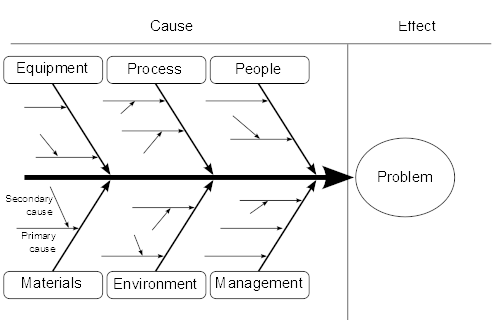The key to achieving business goals is ensuring every process is executed correctly. Therefore, companies must implement internal process improvement to identify possible issues behind a particular function.
Ishikawa diagram, famous as the fishbone diagram, was invented by the quality management innovator Kaoru Ishikawa in the 1960s. This tool has proved to be a magic tool for businesses in resolving their problems.

image credit: Wikimedia Commons
With a fishbone ishikawa diagram template, a business can efficiently focus on resolving a particular problem instead of working towards solving its causes.
This article explains how you can use this visual cause-and-effect analysis tool to identify the causes of a particular problem.
What Is a Fishbone Diagram?
A fishbone diagram is an analysis tool that helps businesses visualize possible causes to identify the root cause of a specific problem. Moreover, this diagram can also be used to examine what can go wrong in the future.
One of the significant reasons to construct a fishbone diagram for your business operations is that it helps identify the underlying issue within the development process, allowing team members to analyze and implement the proper techniques to solve the problem.
The 3 R’s Of Fishbone Diagram
We all are familiar with the three Rs of waste management; “reduce, reuse, and recycle.” Therefore, the fishbone diagram has its own set of 3 Rs: “Recognize, Rectify, Replicate.”
1. Recognize
The first step to constructing a fishbone diagram is identifying the real cause of a specific error. Even though the fishbone diagram is time-consuming, its primary goal is to address the root cause of a particular problem so that the team can take suitable measures to prevent the same problem from recurring.
2. Rectify
If the root cause isn’t successfully identified, the problem will likely rise again. In other words, if the same problem happens again, the root cause you specified may not be the right and leading root cause. Once the root cause is recognized, it’s time to begin corrective action.
3. Replicate
After the problem and its root cause are identified, the next step is to ensure that it doesn’t happen again. For example, if there was an error during the manufacturing process, but now you’ve resolved it. Next, to make sure the problem doesn’t happen again.
When To Use Fishbone Diagrams
The fishbone diagram, also known as the Ishikawa diagram, is a process that aims to identify a problem and reveals multiple causes of that problem to address the primary root cause.
The fishbone diagram can improve the process quality of various business departments such as product development, manufacturing, etc. It’s a tremendous cause-and-effect analysis tool that enables people to develop creative thinking and problem-solving techniques. Some common conditions where a company can use a fishbone diagram are:
- Finding the leading cause behind a failing system
- To identify bottlenecks or areas of improvement in business projects
- To avoid recurring the same issues
- Potential roadblocks or weak areas in product development
- Prevention of quality defect
- Difficulty in understanding the contributing factors in a failing process
- Planning new techniques and strategies through brainstorming
Benefits Of Constructing A Fishbone Diagram
As discussed, the fishbone diagram is a visual analytical tool that helps organizations address potential roadblocks in their projects. Learning how to construct a fishbone diagram can deliver huge success strides in your business. Below are some benefits of creating a fishbone diagram for your business projects.
Creative Ideation
One of the most prominent benefits of the fishbone diagram is it enables creative thinking ability in team members to generate ideas. Furthermore, as this diagram provides all the potential roadblocks and contributing factors to a process error, it helps develop unique ideas.
Boosts Focus
The Ishikawa diagram depicts all the possible causes under one roof to help team members focus on problems that are significant to their business.
Project Detail
As a visual analytical tool, the fishbone diagram is an excellent means to give organizations the freedom to dig into as much detail as possible. Listing out causes and problems in a particular operation allows you to understand them from all possible aspects.
Final Verdict
The value and efficiency of the fishbone diagram depend on how well it is constructed. Therefore, the knowledge, creative thinking, understanding, and project execution of the team members involved in developing a project play an integral role in crafting the fishbone diagram.